After months of diplomatic negotiations and significant anticipation, Sweden has finally gained entry into the NATO alliance—an accomplishment hailed as a major success for the Biden administration. This development holds immense geostrategic significance, particularly in the context of the ongoing conflict between Ukraine and Russia. With Sweden’s inclusion, the dynamics of power in the Baltic region and beyond have shifted, marking a potential turning point in international relations.
A Shift in Naval Power and Geostrategic Influence
Sweden’s accession to NATO directly affects Russia’s maritime capabilities, marking a profound shift in naval dynamics. The entire northern coastline of the Baltic Sea now falls within the ambit of the NATO alliance, with Sweden acting as the final link in this strategic chain. This situation contrasts starkly with the southern Baltic coast, where most areas already reside under NATO’s umbrella, save for the Russian-administered Kaliningrad and a small portion of Russian territory near St. Petersburg. The Russian fleet must now navigate over 1,000 miles of NATO territorial waters to access the open ocean—a significant obstacle that places constraints on their maneuverability. Even the Arctic fleet’s path requires passage along the northern shores of Finland and Norway, both staunch NATO allies. Additionally, Russia’s Black Sea fleet must navigate Turkish-controlled waters before reaching the Mediterranean and Suez, revealing a notable challenge in their strategic operations.
Enhanced Military Capabilities and Unification of Western Powers
Sweden’s robust military infrastructure, particularly its advanced attack aircraft and anti-submarine capabilities, contributes substantially to NATO’s potency. With Finland sharing a nearly 1,000-mile border with Russia, its formidable defenses and well-trained armed forces bolster the alliance’s strength. As Sweden and Finland’s capabilities align with NATO, the collective force becomes far more formidable than during the Ukrainian crisis of 2022. The alignment of Western powers with Baltic nations signifies a historical unity, even surpassing World War II affiliations. The unification of efforts underscores a consolidated front against shared concerns, eliciting concerns among Moscow’s policymakers.
NATO’s Clear Focus and Russia’s Complex Dilemma
NATO’s Secretary General, Jens Stoltenberg, has boldly articulated the organization’s strategic trajectory: ensuring Ukraine’s victory. This unequivocal stance represents a departure from typical diplomatic rhetoric and signifies unanimous agreement among member-states. President Biden’s assertion that Ukraine’s NATO membership is not yet imminent has likely deterred early admittance, highlighting the alliance’s focused approach. Previously apprehensive about provoking direct conflict with Russia, NATO leaders now display a more united front with Baltic nations. However, a note of caution remains—realism about Russia’s capabilities is crucial, given their potential to disrupt Europe without resorting to nuclear weapons.
In light of the recent NATO enlargement and Sweden’s induction, the geopolitical landscape has transformed, catalyzing a cascade of consequences. Russia’s naval maneuverability has been constrained, its military vulnerabilities exposed, and its power projection curtailed. Meanwhile, NATO’s unity and enhanced capabilities provide a robust response to shared concerns. Russia’s complex predicament—torn between Ukraine, domestic fragility, and global dynamics—casts doubt on Putin’s strategic prowess. As the world watches these developments, one thing remains clear: the geopolitical tides are shifting, and the ramifications are reverberating far beyond the shores of the Baltic.















